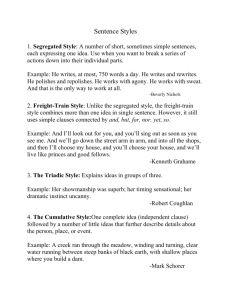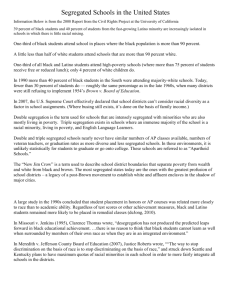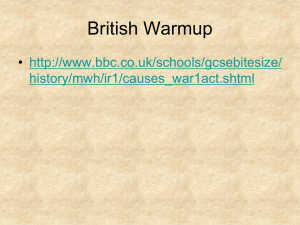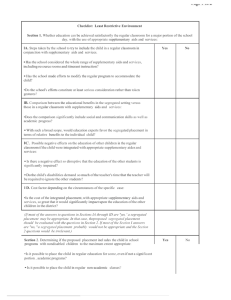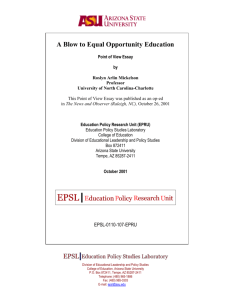early intervention * case study * good new life insurance
advertisement
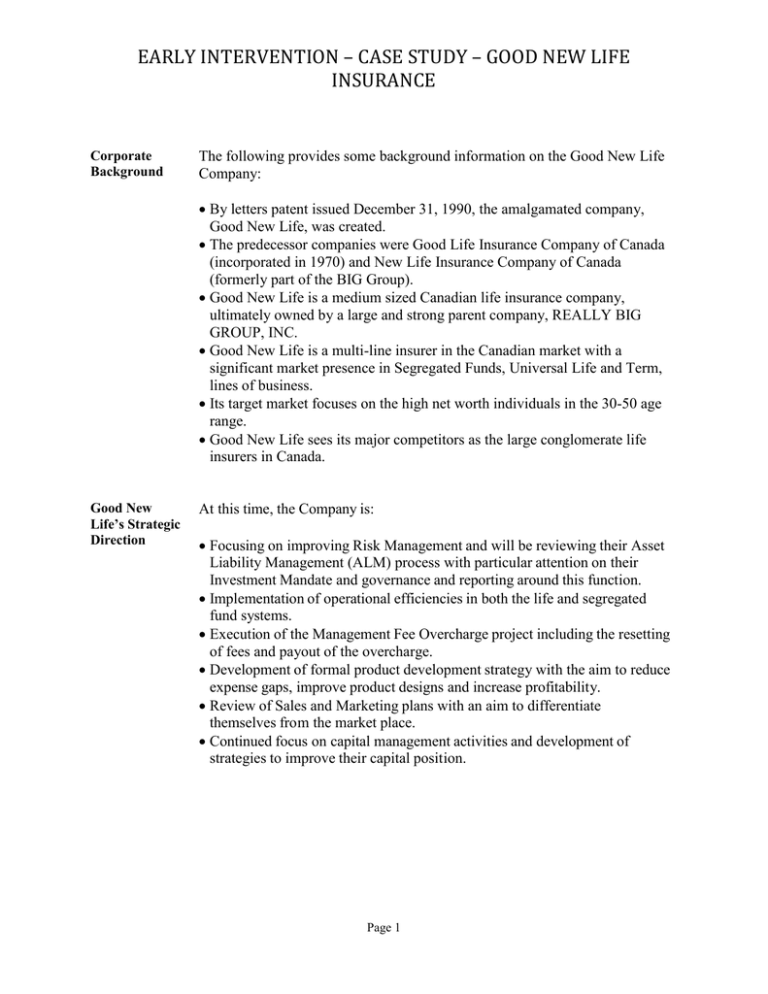
EARLY INTERVENTION – CASE STUDY – GOOD NEW LIFE INSURANCE Corporate Background The following provides some background information on the Good New Life Company: By letters patent issued December 31, 1990, the amalgamated company, Good New Life, was created. The predecessor companies were Good Life Insurance Company of Canada (incorporated in 1970) and New Life Insurance Company of Canada (formerly part of the BIG Group). Good New Life is a medium sized Canadian life insurance company, ultimately owned by a large and strong parent company, REALLY BIG GROUP, INC. Good New Life is a multi-line insurer in the Canadian market with a significant market presence in Segregated Funds, Universal Life and Term, lines of business. Its target market focuses on the high net worth individuals in the 30-50 age range. Good New Life sees its major competitors as the large conglomerate life insurers in Canada. Good New Life’s Strategic Direction At this time, the Company is: Focusing on improving Risk Management and will be reviewing their Asset Liability Management (ALM) process with particular attention on their Investment Mandate and governance and reporting around this function. Implementation of operational efficiencies in both the life and segregated fund systems. Execution of the Management Fee Overcharge project including the resetting of fees and payout of the overcharge. Development of formal product development strategy with the aim to reduce expense gaps, improve product designs and increase profitability. Review of Sales and Marketing plans with an aim to differentiate themselves from the market place. Continued focus on capital management activities and development of strategies to improve their capital position. Page 1 EARLY INTERVENTION – CASE STUDY – GOOD NEW LIFE INSURANCE History of Financial Performance The following table shows the key financial information for the Company. 2009 77 5,907,994 2008 06 5,121,228 2007 5 4,599,920 2006 4,090,818 4,943,719 3,905,938 3,502,738 3,009,778 964,275 1,220,731 1,097,182 1,081,040 4,947,547 5,266,501 5,025,455 4,897,186 Total Revenues ***609,375 903,335 873,948 830,252 Net Income (Loss) **(307,213) 23,549 *(83,858) 95,181 ($000s) Assets Liabilities Total shareholder’s equity Segregated Fund Assets Total MCCSR 155% Tier 1 110% 185% 140% 185% 130% 190% 138% Over the past three years the Company has identified issues of the past and has taken appropriate action to correct the situations. This required the strengthening of reserves in each period. Net Risk in Business Activities Net risk for the key significant activities are rated as follows: Segregated Fund business is rated as High and Decreasing. Universal Life business is rated as Moderate and Stable. Term Life business is rated as Low and Stable. Investment Portfolio is rated as Moderate and Stable. Capital Adequacy Important Information In December 2009, the Company was awaiting a decision from OSFI’s Capital Division with respect to granting of capital credit relating to their segregated funds hedging program. The Q4 2009 Total MCCSR ratio dropped to 155% with a Tier 1 percentage of 110% (185% & 140% at Q4 2008). The percentages are just above OSFI’s supervisory target levels. It was anticipated that in early 2010 capital credit would be granted and the Q1 2010 Total MCCSR and Tier 1 percentages would be at or above the Company’s target capital percentages. The Company’s target total MCCSR ratio is 175% and the Company had been managing their capital above this level until the year-end. The Company’s target Tier 1 ratio is 115% and the Company had been Page 2 EARLY INTERVENTION – CASE STUDY – GOOD NEW LIFE INSURANCE managing well in excess of this target until the year-end. No dividends will be paid without OSFI’s prior approval. The parent REALLY BIG GROUP, INC. continues to support the Company providing capital injections, as required. The last injection of $100 million was in September 2008. It should be noted that OSFI obtained an Undertaking from Good New Life International Holdings Inc. that it ensures that Good New Life Canada will at all times: meet its obligations under the Insurance Companies Act of Canada. maintain adequate capital as determined by OSFI. have sufficient liquidity to meet its obligations as they become due. Summary of Significant Activities and Related Risks Identified The following chart sets out significant activities that are included in the Risk Matrix. Significant Activity Segregated Funds Universal Life (UL) Term Investments Reinsurance SA Yes Yes Yes Yes No Annuities No Actuarial Liabilities No Asset Liability Management (ALM) Information Technology (IT) No No At Q4 2009 segregated funds amounted to $5 billion. Risk related to segregated funds guarantees is a significant at this company. This is a significant line ofissue business which accounts for 64% of net premiums. This is a significant line of business which accounts for 24% of net premiums. At Q4 2009 investments amounted to $5.4 billion. UL and term product lines are over 75% reinsured. As reinsurance is considered when assessing the net risk of the UL and term significant activities, it is not shown as a significant activity on the matrix. This line of business accounts for 7% of net premiums and was not considered a significant activity. Actuarial liabilities were not considered a significant activity as it was considered in the assessment of Inherent Insurance Risk and the Operational Management function. ALM was not considered a significant activity as it was considered in the assessment of the Risk Management and Operational Management functions. IT was not considered a significant activity as it was considered in the assessment of Inherent Operational Risk and Operational Management function. Page 3 EARLY INTERVENTION – CASE STUDY – GOOD NEW LIFE INSURANCE Information on Significant Activities Segregated Funds The following comments provide some general background information: At Q4 2009 segregated funds account value approximated $5 billion. There are a number of funds that date back to the December 1990 amalgamation of Good Life Insurance Company of Canada and New Life Insurance Company of Canada. Characteristics of the older funds included 100% death and maturity guarantees and allowed numerous reset options. New segregated fund products have more conservative characteristics. At Q4 2009 the in-the-money deficiency approximated $895 million. For the year ended December 31, 2009 the net loss for this line of business was $185 million. Net Risk was assessed as High after considering the following: The older segregated funds have significant guarantees. The Q4 2009 in-the-money deficiency is significant at $895 million with the largest exposure arising in 2010 ($680 million). The determination of related reserves and capital requirements is complex and can have a significant impact on earnings and capital. Good New Life is exposed to adverse financial results if equity markets are depressed at maturity. There are some legal challenges relating to the administration of segregated funds that could cost the Company in excess of $90 million. The Direction of Risk was assessed as Decreasing after considering the following: The gap between the segregated funds in-the-money deficiency and related assets remains closed with underlying reserves and capital in excess of the in-the-money deficiency by $92 million at December 31, 2009. (December 31, 2008-$30 million) A hedge on 2 blocks (notional amount of approximately $836 million as at December 31, 2008) was put in place in October/November 2008. This hedging program, which applies to approximately 60% of the account value, reduces volatility with respect to equity market exposure. It is anticipated that a new hedging program will be put in place in early 2010 to obtain capital relief from OSFI. The Company has initiated a “retention” campaign and plans on offering several enhanced product features to encourage clients to stay with the Company beyond 2010. Page 4 EARLY INTERVENTION – CASE STUDY – GOOD NEW LIFE INSURANCE Segregated fund product features have become more conservative than those of the past. The Company monitors the in-the money position very carefully and provides monthly reports to OSFI. Universal Life (UL) The following comments provide some general background information: Universal life accounted for 64 % of net premiums for the year ended December 31, 2009. The average face amount is generally above $250,000. High guaranteed rates on GIA accounts range from 3.5% to 4.25%. New level Cost of Insurance business accounted for 40% of UL net premiums compared with an industry rate of 50%. The UL is 75% reinsured. Net income for the year ended December 31, 2009 amounted to $13 million. Net Risk was rated as Moderate after considering the following: The key driving inherent risk, insurance risk, was rated as Above Average which is mitigated by the fact that the line of business is 75% reinsured when determining the Net Risk for this line of business. UL products are numerous and complex with characteristics that are riskier than most of the products offered by other FIs. The line of business is profitable. Current UL products are more conservative than they were in the past and reserves relating to past UL products have been strengthened. The Direction of Risk was assessed as Stable as no significant change is anticipated in the near future. Individual Term Life The following comments provide some general background information: Term life accounted for 24% of net premiums for the year ended December 31, 2009 The average face amount is generally above $250,000. The term life line is 85% reinsured. Net loss for the year ended December 31, 2009 amounted to $68 million. Net Risk was rated as Moderate after considering the following: Page 5 EARLY INTERVENTION – CASE STUDY – GOOD NEW LIFE INSURANCE The key driving inherent risk, insurance risk, was rated as Moderate which is mitigated by the fact that the line of business is 85% reinsured when determining the Net Risk for this line of business. Lapse experience is monitored on a quarterly basis. Experience studies are conducted on a regular basis. The most recent experience studies concluded that actual mortality experience is better than expected. The line of business is not profitable. The Direction of Risk was assessed as Stable as no significant change is anticipated in the near future. Investment Portfolios December 31, 2009 ($ Millions) Short Term Investments Government Bonds Municipal, Public Authority, Schools Corporate Mortgage Loans (34% insured NHA) Exchange Traded Funds ( Linked) Other Loans Total Book Value 275 1,450 6 2,525 18 1,098 72 5,444 Net Risk for investments is assessed as Moderate for the following reasons: The key driving inherent risk, credit risk was assessed as Moderate with Operational Management and applicable RCMFs assessed as Acceptable. Corporate bonds in the amount of $2.5 billion or 47% of the investment portfolio are well diversified throughout 9 sectors with $1.5 billion invested in the financial sector. 92% of the bonds are rated “A” or higher. Credit risk for investments linked to UL policies is borne by the policyholders. The investment strategy is sound and the Investment Policy Guidelines are very detailed and prudent. The Company is not exposed to the Asset Backed Commercial Paper (ABCP) issue. The Direction of Risk was assessed as Stable as no significant change is anticipated in the near future. Page 6 EARLY INTERVENTION – CASE STUDY – GOOD NEW LIFE INSURANCE Overall Quality of Risk Management Control Functions (RMCF) RMCF Internal Audit Risk Management Senior Management Board of Directors and Committees Other Regulators Rating Acceptable Acceptable Acceptable Acceptable Direction Stable Improving Stable Stable Some provincial regulators are currently finalizing their examinations that addressed the Company’s compliance with its undertaking to treat segregated fund contract holders fairly and in the most beneficial way. The regulators indicated that there would be no sanctions and the Company was in overall compliance with the undertaking. The regulators will be discussing their findings, including some documentation and calculation issues, with the Chairman of the Audit Committee. We will obtain a copy of their reports from the Company and follow-up as required at our 2010 on-site examination. Page 7
